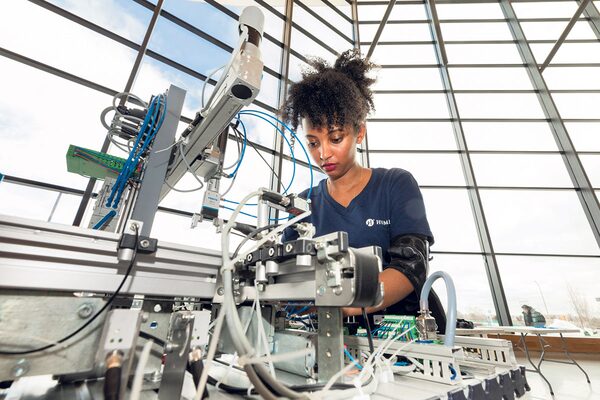
New engineering degrees at Humber College – and a partnership with Sault College – are designed to meet industry needs and hope to attract a diverse cohort.SUPPLIED
While the profession of engineering has changed dramatically over the past century and continues to evolve, its penchant for problem solving has remained constant.
“Engineering has the power to enhance the quality of life for all of us,” says Dr. Farzad Rayegani, senior dean of the Faculty of Applied Sciences and Technology at Humber College, the largest polytechnic in Canada. “Advances in engineering will enable us to tackle the challenges of today and tomorrow, and help identify solutions in many fields, from health care, food production, manufacturing, computing and energy, to the environment and more.”
The idea of acquiring skills that can be applied in a range of sectors plus the promise to work with advanced technology can serve to attract students to the field, predicts Dr. Rayegani, and Humber is offering three new Bachelor of Engineering degrees, with each of the programs designed to meet the accreditation requirements of the Canadian Engineering Accreditation Board.
“We are excited to launch these new engineering degrees, which include 12-month co-op placements and industry specializations,” he says. Internet of things and data network and security specialization are part of the Bachelor of Engineering - Information Systems Engineering program. Students enrolled in the Bachelor of Engineering - Built Environment can specialize in sustainable building as well as built environment information systems. Bachelor of Engineering-Mechatronics students can choose robotics or embedded systems specializations.
“There is strong alignment with what our industry and community partners are looking for from our graduates, and we feel confident that our team of faculty and administrators have built these degrees on a common platform that includes an innovative engineering educational framework,” notes Dr. Rayegani.
Demand for skilled engineers is high in the Toronto Waterloo corridor, where Humber is located, as well as across the country.
Dr. Farzad Rayegani“Advances in engineering will enable us to tackle the challenges of today and tomorrow, and help identify solutions in many fields, from health care, food production, manufacturing, computing and energy, to the environment and more.
Senior dean of the Faculty of Applied Sciences and Technology at Humber College
In northern Ontario, for example, “many companies are turning to automation for efficiency and productivity purposes, so they need graduates who can help them advance their industry 4.0 automation and digital technology interests,” says Colin Kirkwood, a professional engineer and vice president, academic, Sault College of Applied Arts and Technology, which has a legacy of meeting the workforce needs of local employers in the Sault Ste. Marie area.
The Bachelor of Engineering-Mechatronics program, which will be co-delivered by Humber and Sault College, is envisioned to strengthen pathways to success for students as well as help advance the innovation agenda of regional industry.
Students can complete their degree while gaining work experience in their communities, explains Dr. Rayegani. “We are offering a new blended-learning methodology that includes challenge-based and project-based learning and lab activities, which students can pursue on their campus.”
Both Humber and Sault College bring “close connections to different regional industries, so combining our collective knowledge and expertise makes sense,” says Mr. Kirkwood. “[Industry partners] have made significant investments in lab and research equipment at the college so students can gain industrial experience and are comfortable with the equipment when they graduate.
“This infrastructure also allows us to do applied research. Local employers undertaking proof-of-concept projects bring their real-life problems to us and work with students to solve them,” he adds. At an applied research cell with an automated manufacturing line that is part of Sault College’s robotics centre, students become familiar with equipment that enables them to “hit the ground running when they enter their jobs,” says Mr. Kirkwood.
Colin Kirkwood“[Industry partners] have made significant investments in lab and research equipment at the college so students can gain industrial experience and are comfortable with the equipment when they graduate.
Vice president, academic, Sault College of Applied Arts and Technology
Similarly, Humber prepares its graduates to be “career ready from day one,” states Dr. Rayegani. “Methodology of the engineering programs is based on the integration of project-based learning with state-of-the-art equipment. This blended approach encourages students to develop their problem-solving and critical-system thinking skills through their involvement in real-life industrial projects. In addition, our Humber living labs, through centres of innovation, play a critical role in fostering the next generation of engineering leaders.”
Humber’s automation and robotics division at the Barrett Centre for Technology Innovation is “unique in the GTA, in Ontario and even across Canada,” says Dr. Rayegani, who has observed accelerating demand for this kind of infrastructure and expertise.
He hopes the partnership with Sault College can serve as a model for other college or university collaborations and envisions welcoming a diverse cohort.
Diverse views and approaches, including from women and Indigenous people, can help engineering be more effective in addressing existing and emerging challenges, says Mr. Kirkwood, who adds that with Engineers Canada predicting a net deficit of engineers in Canada over the next five years due to a high number of retiring professionals, engineering comes with promising job prospects.
From robots used in surgery to smart homes and cars guided by sensor technology, engineering touches virtually all aspects of society. And the opportunities are boundless, so why not consider joining the ranks of the engineers of the future?
Advertising feature produced by Randall Anthony Communications with Colleges and Institutes Canada. The Globe’s editorial department was not involved.